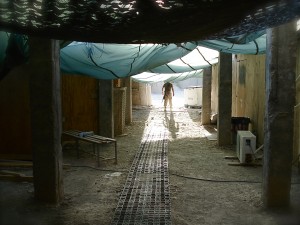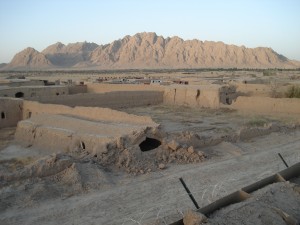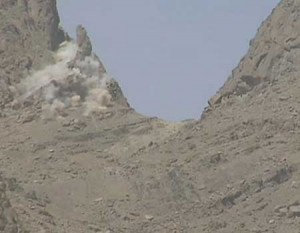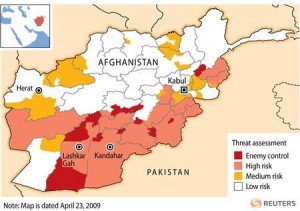Ten Dollar Taliban and Rules of Engagement
BY Herschel SmithThe AP has an informative update on the U.S. Marine efforts in Now Zad.
After three tours in Iraq, U.S. Marine Sgt. Andre Leon was used to brutal shootouts with enemy fighters and expected more of the same in Afghanistan.
Instead, what he’s seen so far are anonymous attacks in the form of mines and roadside bombings — the mark of what he calls a cowardly adversary.
“I’m not impressed with them,” Leon, 25, of Herndon, Va., said this past week from a Marines camp deep in the southern province of Helmand, where U.S. forces are challenging Taliban insurgents and their devastating use of IEDs, or homemade bombs. “I expected more of a stand-and-fight. All these guys do is IEDs.”
Marines on the front lines in southern Afghanistan say there’s no question that the militants are just as deadly as the Iraqi insurgents they once fought in Iraq’s Anbar Province. The Afghan enemy is proving to be a smaller, but smarter opponent, taking full advantage of the country’s craggy and enveloping terrain in eluding and then striking at U.S troops.
In interviews, Marines across Helmand said their new foes are not as religiously fanatic as the Syrian and Chechen militants they fought in Iraq and often tend to be hired for battle. U.S. commanders call them the “$10 Taliban.”
Taking advantage of the Afghanistan’s mountainous rural landscape, the fighters often spread out their numbers, hiding in fields and planting bombs on roads, rather than taking aim at U.S. forces from snipers’ nests in urban settings, as often was the case in Iraq. And they are not as bent on suicide, often retreating to fight another day.
“One thing about Afghanistan, they’re not trying to go to paradise,” said Sgt. Robert Warren, 26, of Peshtigo, Wis. He served a tour in both Iraq and Afghanistan before his current assignment at Combat Outpost Sharp, a Marines camp hidden in cornfields and dirt piles.
“They want to live to see tomorrow,” Warren said. “They engage with us, but when they know we’ll call in air support, they’ll break contact with us. … They’re just as fierce, but they’re smarter.”
Marine commanders believe they face between 7,000 and 11,000 Taliban fighters in Afghanistan, although it is unclear how many are low-level militants hired for battle as opposed to extremist leaders.
By comparison, officials still are unsure how many members of al-Qaida in Iraq remain. Earlier estimates ranged between 850 to several thousand full-time fighters, although commanders believe that number has been reduced significantly as a result of counterinsurgency efforts in Iraq …
Both foes are also sometimes known to use drugs — troops have reported finding syringes and needles in enemy camps.
Training does not seem to be an issue for Marines who have been making the transition from Iraq to Afghanistan. Their skills appear to have held up in both war zones.
But new U.S. battle guidelines that limit shooting into or otherwise attacking buildings without ensuring there are no civilians inside have at times made the fighting more difficult.
The rules were put into place this summer after dozens of Afghans were killed in a May battle in Farah province that ended when U.S. forces bombed a building where Taliban fighters were believed to be hiding.
“It’s frustrating to be attacked from a building,” said Lt. Joe Hamilton of Baltimore as he scrutinized two-story village structures on the other side of dirt-and-barbed wire walls at Combat Outpost Fiddler’s Green. “You can’t shoot back because you don’t know if there are civilians there.”
He added: “They’re more disciplined. They wait longer until we get in their kill zones, then they attack us.”
In Anbar the insurgency was bifurcated between the indigenous fighters and the foreign elements who fought for religious reasons. In Fallujah in 2007 fighters from Chechnya, Somalia, and other countries were killed by the 2/6 Marines. They were found to have been taking epinephrine and morphine before engagements.
It’s a positive development that although the indigenous fighters are disciplined, they aren’t fanatics. They only work for people who are fanatics. Scores of them might still have to be killed in order to convince them that a few dollars isn’t worth the risk. But the situation is not good for the Marines.
Recall that we have had this debate about rules of engagement and the fact that the Marines cannot possibly be assured in these cases that there aren’t noncombatants inside structures. Thus, not only would the 2008 Marine Corps operations in Garmsir not have occurred, but the Taliban will learn to seek refuge in structures very quickly in these engagements.
It was a simple observation but for some reason difficult for others to understand. “You can’t shoot back because you don’t know if there are civilians there.” And thus the warfare ends and the game begins. I suspect that it will be a deadly game for the noncombatants and Marines alike, regardless of the intent of the rules.








